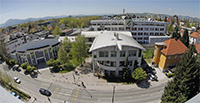The COST 237 Action, which is part of COST Telecommunications, one of the technical area of the COST program, started officially in February 1992 when four countries (Belgium, Denmark, France and Germany) signed the MoU (Memorandum of Understanding) defining the Action.
Aims and Scope of COST 237
COST 237 intends to be active in the following areas:
- Specification of the Communication Related Service Requirements necessary to allow the distribution of those advanced multimedia applications which have been developed in national and other pan-European projects (and are mainly standalone). These Communication Related Service Requirements will have to be mapped into an architecture providing inter-operability.
- Assessment of suitable networks, service elements and Quality of Service (QoS) for the implementation of the Communication Related Service Requirements of these multimedia applications.
- Enhancement of the service specification of existing standard reference models, taking into account user requirements.
- Enhancement of the communication support for multimedia applications.
The extent of distribution of these open multimedia services is considered to cover three different areas:
- Within large businesses (local site, intersite);
- Within small businesses;
- To the home.
It is the intent of the action to contribute to the standardization by submitting the results of its research to the relevant Technical Committee.
COST 237 Working Groups
The work of the Action is carried out through its working groups. Two working groups were initially created to achieve the aim of the Action.
The WG 1, “Multimedia Teleservices”, was established to examine a number of models used to describe enhanced multimedia teleservices and applications such as Video on Demand (VoD), teleconferencing or jointworking applications. Improvements to these models have been suggested and discussed by the group. Some members of this working group have focused on analysing the security implications for some of the teleservices examined. A new working group has been created with new aims and scope ( WG4 Security and Applications).
The work in the WG 2, “New Transport Service Specification”, was based on the recognition of the key role played by the transport service in matching the new requirements of cooperative multimedia applications to the increasingly sophisticated support offered by emerging network technologies. After two years of activity, WG2 has been highly successful in its aims as it has defined an enhanced multimedia transport service incorporating both quality of service (QoS) specification and multipeer connectivity, and made substantial contributions to the ISO SC6 Multipeer Taxonomy. Once its objectives successfully completed, this working group closed its activities on November 1995. The work of mapping the transport service defined by it to the underlying network technologies has resulted in the creation of a new working group, the WG 3.
The new WG3, “Communications Support for Multimedia Applications”, will build on the work of WG2 by considering the protocols and mechanisms necessary to underpin the enhanced transport service. Its concern will thus be the detailed mapping of the transport service onto network technologies (primarily ATM-based and Internets) and end-systems. The WG 3 will focus on developing an understanding of the protocols required for multicasting, resource management, media-scaling, and distributed control (signalling) in a heterogeneous network and end-system environment. Another important area of study will be the influence of application characteristics such as media encoding on protocol design, as well as application-oriented design. In addition, work on billing and pricing of network services will be taken into account as an influencing factor in multimedia protocol design.
The WG 4, “Security and Applications”, was created by members of WG1 who wanted to examine the security aspects associated with the production and delivery of a wide range of Multimedia Teleservices. Pay-TV broadcasting and authentication for logging have been the most studied secured multimedia mechanisms until now. The aim of this group is to enlarge those studies in a more general framework. The group is examining the development of a functional model for the securing of the multimedia chain, including the actors, the functions and the messages. An inventory of the existing cryptographic tools will then be performed. Finally, those tools will be extended in complex situations like CSCW or intelligent agents remote down-loading. In a general way, the conditional access to services will be considered through monitoring and/or filtering. Ensuring the authenticity and integrity of the data flow will also be considered. In the area of copyright protection the group will consider the applicability and the management of existing techniques like watermarking and labelling. These topics will be studied in four communication configurations, namely, broadcast, client-server, CSCW and peer-to-peer.


